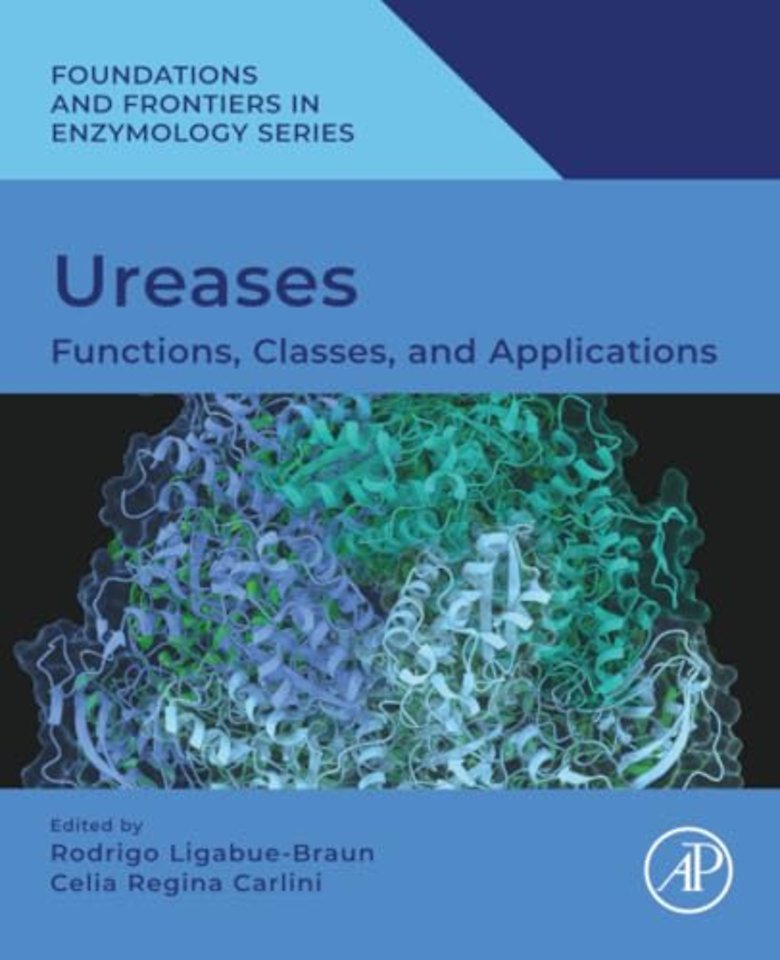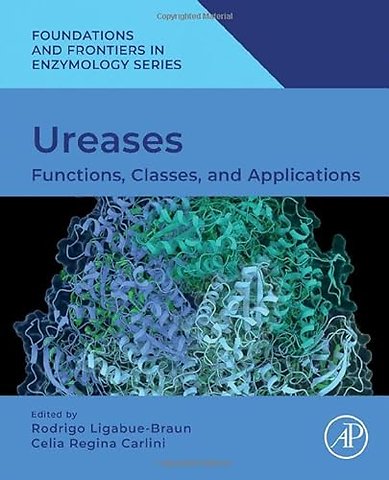<p>List of contributors<br>About the editors<br>Preface<br><br>Part I Introduction<br><br>1 Ureases: an overview<br>Conrado Pedebos and Rodrigo Ligabue-Braun<br><br>1.1 Introduction<br>1.2 Structure and activation<br>1.3 Relevance in health and technology<br>1.4 Conclusions<br>References<br><br>Part II Historical aspects<br><br>2 Historical hallmarks in urease study<br>Paula Bacaicoa Caruso and Rodrigo Ligabue-Braun<br><br>2.1 Introduction<br>2.2 From urea to urease: 1700-1900<br>2.3 Enzymes are proteins and they can have nickel: 1900-75<br>2.4 Structure-function(s) of urease: 1981currently<br>2.5 Urease origins: notes on urease prehistory<br>References<br><br>3 Genetics of plant urease, the enzyme that keeps surprising us<br>Joe C. Polacco<br><br>3.1 An innocent young man<br>3.2 A quixotic quest: biological and biographical background<br>3.3 The urease play, with a cast of “firsts”<br>3.4 Nickel enters the fray<br>3.5 Soybean urease isozymes enter the fray<br>3.6 Nickel insertion proteins enter the fray (in vitro activation of soybean urease)<br>3.7 Does urea enter the fray? Of course, but from which tissues?<br>3.8 Dueling metabolic precursors of urea enter the fray<br>3.9 A urease-mediated insight into plant associations with bacteria<br>3.10 Other nickel roles in the plant world?<br>3.11 Are urea and NO children of the same parents?<br>3.12 Dedication<br>References<br><br>Part III Classes and special cases<br><br>4 Microbial ureases<br>Celia Regina Carlini, Deiber Olivera-Severo and Rodrigo Ligabue-Braun<br><br>4.1 Historical aspects and relevance of microbial ureases<br>4.2 Structural organization of microbial ureases and evolution<br>4.3 Genomic organization and expression regulation of bacterial ureases<br>4.4 Urease-negative bacteria<br>4.5 Beneficial roles of bacterial ureases<br>4.6 Microbial ureases as virulence factors<br>4.7 Nonenzymatic properties of three-chained ureases<br>4.8 Concluding remarks<br>References<br><br>5 Plant ureases: biochemistry, structure, physiological functions, role of urease inhibitors, and urease applications in industry<br>Sandeep Kumar and Arvind M. Kayastha<br><br>5.1 Introduction<br>5.2 Historical milestones of urease<br>5.3 Biochemistry of urea catalysis<br>5.4 A Ubiquitous enzyme<br>5.5 Structure of plant urease<br>5.6 Urease inhibitors of agricultural interest<br>5.7 Physiological role of urease in plants<br>5.8 Nonenzymatic properties of plant ureases<br>5.9 Applications of ureases<br>5.10 Conclusion<br>References<br><br>6 Jack bean urease<br>Anuradha Balasubramanian and Karthe Ponnuraj<br><br>6.1 Introduction<br>6.2 Role of plant urease<br>6.3 Urease architecture<br>6.4 Challenges in crystallizing jack bean urease<br>6.5 Crystallization of JBU<br>6.6 X-ray analysis of native and fluoride-inhibited JBU<br>6.7 Structure determination of native and fluoride-inhibited JBU<br>6.8 Structure of JBU monomer<br>6.9 Oligomeric assembly<br>6.10 Active site architecture of JBU<br>6.11 Active site mobile flap<br>6.12 Insecticidal activity<br>Acknowledgment<br>References<br><br>7 Fungal ureases<br>Alfred Botha and Barbra Toplis<br><br>7.1 Introduction<br>7.2 Producers of fungal ureases<br>7.3 Environmental role of fungal ureases<br>7.4 Fungal ureases as virulence factors<br>7.5 The role of ureases in fungal cell metabolism<br>7.6 Conclusion<br>References<br><br>Part IV Activation, catalysis, inhibition<br><br>8 Urease: structure, function, catalysis, and inhibition<br>Luca Mazzei, Francesco Musiani, Barbara Zambelli, Stefano Benini, Michele Cianci and Stefano Ciurli<br><br>8.1 Introduction<br>8.2 The three-dimensional architecture of ureases<br>8.3 The active site of urease<br>8.4 The urease operon<br>8.5 The accessory proteins of urease<br>8.6 The urease maturation process<br>8.7 The catalytic mechanism<br>8.8 The inhibition of urease<br>References<br><br>9 Inhibition of ureases: studies and applications<br>Robert P. Hausinger<br><br>9.1 Introduction: the importance of urease inhibitors and inactivators<br>9.2 Proper design of urease inhibitor/inactivator studies<br>9.3 Inhibitors that bind directly to the urease metallocenter<br>9.4 Inactivators that react with the flexible protein flap covering the urease active site<br>9.5 Other compounds that reduce urease activity<br>9.6 Conclusion<br>Acknowledgments<br>References<br><br>10 Nonenzymatic properties of ureases<br>Matheus V.C. Grahl, Augusto F. Uberti and Celia Regina Carlini<br><br>10.1 Introduction<br>10.2 Entomotoxic property of plant ureases<br>10.3 Antifungal effect of ureases<br>10.4 Exocytosis-inducing activity of ureases<br>10.5 Pro-inflammatory properties of ureases<br>10.6 Neurotoxicity of ureases in rodents<br>10.7 Structure versus nonenzymatic activities of ureases<br>10.8 Concluding remarks<br>Acknowledgments<br>References<br><br>Part V Health applications<br><br>11 Ureases as drug targets in urinary tract infections<br>Charles E. Deutch<br><br>11.1 Urinary tract infections<br>11.2 Role of urease activity in urinary tract infections<br>11.3 Ureases from urinary tract pathogens<br>11.4 Ureases from gram-negative bacteria<br>11.5 Ureases from gram-positive bacteria<br>11.6 Inhibition of uropathogenic ureases by specific chemicals<br>11.7 Hydroxyurea and other urea analogs<br>11.8 Acetohydroxamic acid and other hydroxamates<br>11.9 Flurofamide and other phosphoramides<br>11.10 Polyphenolic compounds<br>11.11 Omeprazole and other imidazoles<br>11.12 Inhibition of uropathogenic ureases by herbal extracts<br>11.13 Green tea extract<br>11.14 Uva ursi extract<br>11.15 Cranberry extract<br>11.16 Garlic extract<br>11.17 Other extracts<br>11.18 Further studies<br>11.19 New chemical inhibitors of urease activity<br>11.20 Inhibition of urease formation<br>11.21 Inhibition of Ni21 incorporation<br>11.22 Urease-specific vaccines<br>11.23 Conclusions<br>References<br><br>12 Ureases as drug targets in fungal infections<br>Anne Helene Souza Martinelli, Ana Paula Artusi Perin and Fernanda Cortez Lopes<br><br>12.1 Fungal infections<br>12.2 Fungal targets to drugs<br>12.3 Ureases as virulence factors in fungi<br>12.4 Fungal ureases as drug targets<br>References<br><br>Part VI Biotechnological applications<br><br>13 Reaching food security: harnessing urease inhibitors to meet the challenges of growing global population<br>Andre´ia C.S. Ferreira, Rosana C. Cruz, Clara Q. Rosa, Aˆngelo de Fa´tima and Luzia V. Modolo<br><br>13.1 Introduction<br>13.2 NBPT as a promoter of crop production<br>13.3 Use of hydroquinone<br>13.4 Use of Azolla to improve NBPT effectiveness<br>13.5 Use of Limus<br>13.6 Use of biochar<br>13.7 Use of biological preparations<br>Acknowledgments<br>References<br><br>14 Ureases as pesticides<br>Leonardo Luis Fruttero, Natalia Rita Moyetta, Matheus V.C. Grahl, Anne Helene Souza Martinelli and Fernanda Cortez Lopes<br><br>14.1 Introduction<br>14.2 Synthetic pesticides versus biological control<br>14.3 Ureases as pesticides<br>14.4 Final conclusions and perspectives<br>Acknowledgment<br>References<br><br>15 Ureases in the beverage industry<br>Elisa Tavilli and Marcello Fidaleo<br><br>15.1 Introduction<br>15.2 Acid urease<br>15.3 Application of acid urease to beverages<br>15.4 Kinetics of urea removal in wines<br>15.5 Use of immobilized acid urease in beverages<br>15.6 Concluding remarks<br>References<br><br>16 Versatility of ureases: many uses for biotechnological and medical applications<br>Kelvin Siqueira Hohl, Evelin Furtado Meirelles and Celia Regina Carlini<br><br>16.1 Why urease? Historical aspects of urease-based applications<br>16.2 Immobilization of ureases<br>16.3 Biocementation, bioremediation, and archeology<br>16.4 Dairy production<br>16.5 Beverage industry<br>16.6 Urease-assisted chemical synthesis<br>16.7 Biosensors<br>16.8 Medical applications<br>16.9 Concluding remarks<br>References<br><br>Index</p>

